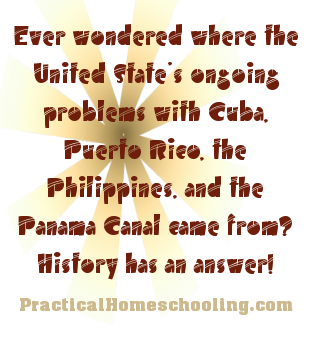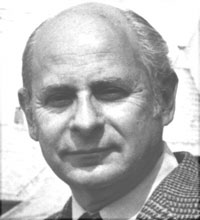Forgotten American History: The Spanish-American War
By Sam Blumenfeld
Printed in Practical Homeschooling #55, 2003.
 Ever wondered where the United State’s ongoing problems with Cuba, Puerto Rico, the Philippines, and the Panama Canal came from? History has an answer!
Ever wondered where the United State’s ongoing problems with Cuba, Puerto Rico, the Philippines, and the Panama Canal came from? History has an answer!

|
 |
 One of the most important events in American history, the Spanish-American War, has been virtually erased from our national memory by the more spectacular events of the 20th century. But anyone who wants to know about our ongoing problems with Cuba, Puerto Rico, the Philippines, the Panama Canal, etc., would have to know their origin in what Secretary of State Hay called that "splendid little war." It might have been a little war, but it had a big impact on our sense of "manifest destiny," a phrase used to suggest the inevitability of American expansion. By the 1870s, the United States covered the continent from coast to coast, had acquired Alaska from the Russians in 1867, and in 1875 ratified a treaty with Hawaii, which would lead to its eventual statehood.
One of the most important events in American history, the Spanish-American War, has been virtually erased from our national memory by the more spectacular events of the 20th century. But anyone who wants to know about our ongoing problems with Cuba, Puerto Rico, the Philippines, the Panama Canal, etc., would have to know their origin in what Secretary of State Hay called that "splendid little war." It might have been a little war, but it had a big impact on our sense of "manifest destiny," a phrase used to suggest the inevitability of American expansion. By the 1870s, the United States covered the continent from coast to coast, had acquired Alaska from the Russians in 1867, and in 1875 ratified a treaty with Hawaii, which would lead to its eventual statehood.
Our war against Spain was ignited by the latter's harsh suppression of the Cuban insurrection against Spanish rule which began in February 1895. As a result of the fighting, American investments in Cuba suffered. Meanwhile, the American press reported the cruelty of Spain's methods of warfare, and built up among Americans considerable sympathy for the Cubans fighting for their freedom. The press urged American intervention to stop the atrocities.
President Cleveland (1893-97) resisted such pressure for intervention, and so did his successor, President McKinley (1897-1901). In fact, Spain, with a new liberal government, abandoned its objectionable military methods and offered the Cubans limited autonomy. But on February 15, 1898, the U. S. battleship Maine blew up in Havana harbor, killing two officers and 258 sailors. It created a huge outburst of anti-Spanish sentiment, fanned by the press, which wanted war.
President McKinley then asked Congress for the authority to use U.S. forces to end the civil war in Cuba. Congress promptly passed resolutions recognizing the independence of Cuba, demanding that Spain withdraw from the island, which the Spanish had ruled for hundreds of years. On April 25, 1898, Spain severed diplomatic relations with the U.S., and Congress declared war retroactive to April 21st.
A blockade of Cuban ports was begun on April 22, but the first dramatic event of the war took place in the Far East. On May 1, Commodore George Dewey, in command of the U.S. Asiatic Squadron, entered Manila Bay in the Philippine Islands and destroyed the antiquated Spanish fleet which defended it. The City of Manila itself was occupied by American troops on August 13th.
While events in the Philippines were proceeding victoriously, Cuba posed a different problem. Spain's Atlantic fleet, under Admiral Cevera, had entered the harbor at Santiago, at the far eastern end of Cuba, on May 19th. There, they were blockaded by an American fleet under Rear Admiral W.T. Sampson. The object of the U.S. was to destroy the Spanish fleet.
An army of 18,000 regulars and volunteers assembled at Tampa, Florida. They were transported to the Cuban coast east of Santiago in June. Commanded by Gen. W.R. Shafter, the American army stormed the heights overlooking Santiago in the battles of El Caney and San Juan Hill, the famous battle in which Lt. Col. Teddy Roosevelt and the Rough Riders achieved their great reputation for bravery and courage which would be used later to propel Roosevelt to the Presidency.
With the Spanish position in Santiago rendered untenable, Cevera was ordered by Capt. Gen. Blanco to lead his fleet out of the harbor. As the fleet tried to leave Santiago on July 3rd, the Americans attacked and destroyed it. The destruction of Cevera's fleet practically ended the war. The city of Santiago was surrendered on July 16th. Nine days later, Gen. Nelson A. Miles landed virtually unopposed in Puerto Rico and occupied the island.
The Spanish government then sued for peace, and on August 12th hostilities were terminated. Under the protocol, Spain gave up Cuba, ceded Puerto Rico and the Ladrone Islands (Guam) to the U.S., and agreed to the U.S. occupation of Manila. The treaty of peace was signed in Paris on December 10, 1898, and approved by the Senate on February 6, 1899. A sum of $20 million was paid to Spain for its cession of the Philippines to the U.S.
Thus, at a cost of $250 million and over 5,000 lives, of which fewer than 400 actually were killed in battle, the United States, in a war lasting six months, had acquired a colonial empire and had risen to a position of prominence in world affairs. And now you know how we got to own Puerto Rico and Guam.
All of this took place while America was growing into a formidable industrial power. We were on the threshold of an economic expansion beyond our wildest dreams. The automobile had just been invented and was destined to revolutionize the globe. American missionaries had gone into all parts of the world to bring the message of the Gospel to people who needed to hear it. Thus, America's forgotten little war should be remembered in the context of our great manifest destiny.